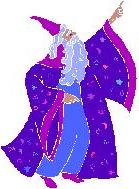Guest Post by Tristan Brand
 Magic has been a part of our stories since pretty much the beginning.
Magic has been a part of our stories since pretty much the beginning.
Homer wrote The Odyssey, a tale full of magical creatures, sorceresses, and vengeful gods, nearly three millennia ago. The Arthurian legend, featuring the great wizard Merlin and King Arthur’s magical sword Excalibur, originated in the dark ages. Five hundred years ago, Shakespeare incorporated magic into plays like A Midsummer Night’s Dream. Magic made an appearance in Wagner’s famous opera Der rings des Nibelungen, a story of a magical ring that drew from the same sources which, a century later, inspired Tolkien to write his masterpiece Lord of the Rings.
Magic’s a powerful tool when it comes to storytelling. When a writer decides to include magic in his story, he needs to understand the implications of whatever type of magic they include. Of course, that’s easier said than done, as there are essentially infinite ways to approach magic.
We can make this infinite sea of possibility a bit more manageable by dividing magic into two categories. In the first category, the laws of magic are as well understood as the laws of physics. In the second category, magic is a mystery; its rules, laws, limitations are left unknown.
Both categories carry their own advantages and potential pitfalls. Fortunately, there are a number of excellent stories representing each category that can be used as examples of how the strongest storytellers use magic.
Brandon Sanderson is a great example of an author whose magic falls into the first category. In his Mistborn series, people called allomancers burn metals within their bodies to give themselves abilities ranging from pulling their bodies towards pieces of metal to affecting the flow of time. Sanderson carefully weaves in information about allomancy into the narrative so that the reader learns its capabilities and limitations, while taking care not to bog the story down with excessive detail.
In crafting allomancy, Sanderson made use of a couple principles (which he often terms his first and second law of magic.) The first is that the author’s ability to use magic to solve conflicts is directly proportional to the reader’s understanding of said magic. The second is that magic must have significant draw-backs to those that use it.
The first law demonstrates the key advantage to using well-understood magic. It allows that magic to become a tool in the author’s tool-box. The second law offers a cautionary point. If the writer creates a magic system that’s too powerful, the reader may at some point wonder why the hero is going through all this trouble
Vin, the protagonist in Mistborn, is a powerful allomancy who routinely uses her ability to solve problems. If the reader didn’t understand allomancy, Vin’s constant use of it to escape danger would seem cheap. If allomancy did not have significant limitations, the reader might wonder why Vin was letting herself get into so much trouble in the first place.
The magic in George R. R. Martin’s epic series A Song of Ice and Fire falls into the second category. Magic appears directly on the page far less than in most fantasy novels, though it’s always lurking in the edges. Undead monsters rise in the North. A summoned shadow assassinates a would-be king. A crippled boy can project his mind into the body of his pet wolf.
If there’s an underlying logic, a set of principles governing what can and cannot happen, Martin keeps it well-hidden from the reader. A key reason this works is that Martin’s magic is just as mysterious to the viewpoint characters as it is to the reader. The mysteriousness of his magic is not an arbitrary choice but rather a consequence of the world he’s created. In this world, the characters fear magic – and the reader learns to fear it as well.
One pitfall to Martin’s approach is that he is far less able to use magic to solve conflicts, a consequence of Sanderson’s first law. But Martin doesn’t need to. The magic in his world serves a different purpose than the magic in Sanderson’s world.
The trait that both Sanderson and Martin’s approaches share is consistency. Magic might break the rules of nature, but it cannot escape logic and consequence entirely. Adding magic into a world irrevocably changes it. Cities, cultures, politics, wars, everything, will be affected in some way. Regardless which approach is chosen, its success will likely be determined by how consistent the author is with their magic’s effect on the world.
Most authors fall in between the two categories. Patrick Rothfuss uses magic called sympathy in his Kingkiller Chronicles, and though the reader is given some rules there are clearly parts left unexplained. The same is true of weaving in Robert Jordan’s Wheel of Time or the magic in Jim Butcher’s Dresden Files.
Magic may exist only in our minds, but that doesn’t make it any less real. It’s in our stories, and our stories are part of who we are. They reflect our culture, our history. Through stories, even those about dragons and wizards and talking dogs, allomancers and undead hordes, we constantly explore what it means to be human. By allowing the impossible to play out on the page, we can find insights that considering only the possible would have left undiscovered.
***
Tristan Brand is an aspiring fantasy author and technical writer. When he’s not obsessively checking the mail for his long-overdue invitation to wizarding school, he can be found playing StarCraft II, practicing classical piano, or reading a good book. He keeps a blog at www.TristanDBrand.com, does a web-show with his friend called Why We Like It (http://day9.tv/d/b/why-we-

Great post, Tristan. I agree – as long as the author is consistent with the magic and doesn’t use it as a cheat or a shortcut, magic adds wonderful dimensions to a story. I remember one book I read where a very mysterious, undefined type of magic was used by the author at the very end to miraculously fix everything and save the protagonist from certain death. As a reader, I felt cheated because the author used magic as a shortcut and side-stepped the very situation he had so painstakingly created.
Pingback: The Magic in Our Stories | Tristan's Blog
Excellent, Tristan! I enjoyed your conversational style as if we were sitting in a cozy library in front of a blazing fire (It’s chilly in my niche of the world today) and you were akin to a wise and intuitive friend skillfully explaining magic in our story worlds. Thanks! You did a first-rate job!
@Frank Morin Thanks, Frank. It’s funny, I used to think adding magic to stories would make them easier to tell, but as I learn more about writing I’m finding avoiding that feeling of being cheated you describe to be a real challenge.
@Brenda Sills Glad you enjoyed it, Brenda 🙂 I strive for that conversational tone but am never quite sure it’s coming out the way I intend. Very happy it worked for you!
Pingback: The Great Geek Manual » Geek Media Round-Up: March 28, 2013